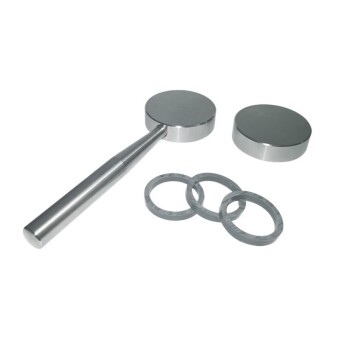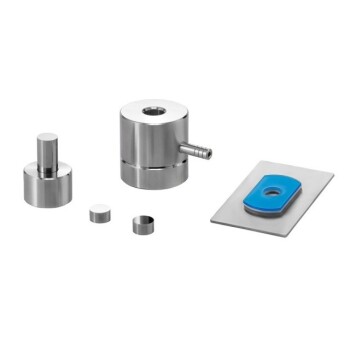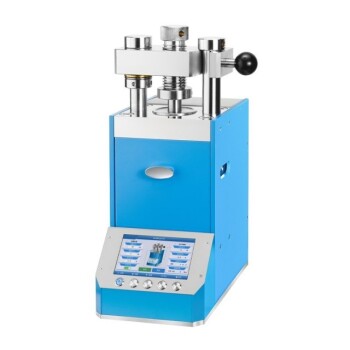In short, the KBr pellet method does not require peak intensity corrections because it is a transmission technique with a fixed, uniform pathlength. The infrared light passes directly through a sample that is thinly and evenly dispersed in a transparent matrix, meaning the relative intensity of all peaks is inherently accurate without the need for the software corrections required by alternative methods like Attenuated Total Reflectance (ATR).
The core difference lies in how light interacts with the sample. In the KBr method, light passes through a fixed thickness. In ATR, light penetrates the sample to a depth that changes with the wavelength, skewing peak intensities and requiring mathematical correction.
The Physics of Transmission vs. Reflection
The need for spectral correction is not a flaw; it is a direct consequence of the physics of the measurement technique. Understanding the difference between transmission (KBr) and reflectance (ATR) is key to interpreting your infrared spectra correctly.
How KBr Pellets Work: A Transmission Method
The KBr pellet method operates on the principle of direct transmission. The solid sample is ground into a fine powder and intimately mixed with potassium bromide (KBr) powder.
Under high pressure, the KBr becomes plastic and forms a solid, glass-like disc that is transparent to infrared light. Your sample is trapped and uniformly dispersed within this transparent KBr matrix.
When the IR beam passes through the pellet, the pathlength—the distance the light travels through the sample—is defined by the physical thickness of the pellet. This pathlength is constant for all wavelengths (or wavenumbers) of light.
The Principle of ATR: Wavelength-Dependent Pathlength
Attenuated Total Reflectance (ATR) works differently. The IR beam is directed into a crystal (like diamond or zinc selenide) and reflects internally. This reflection creates an evanescent wave that penetrates a short distance beyond the crystal surface and into your sample.
Crucially, the depth of this penetration is dependent on the wavelength. The evanescent wave penetrates deeper at longer wavelengths (lower wavenumbers). This means the effective pathlength is longer for peaks in the fingerprint region (e.g., 800 cm⁻¹) than it is for peaks in the functional group region (e.g., 3000 cm⁻¹).
Why This Eliminates the Need for Correction in KBr
Because the effective pathlength in ATR is not constant, the relative intensities of peaks are distorted. Peaks at lower wavenumbers appear artificially more intense than they should. Modern FTIR software applies an "ATR correction" algorithm to mathematically compensate for this physical effect.
With the KBr method, this is unnecessary. Since the pathlength is fixed, the resulting spectrum is a direct and true representation of the sample's absorbance according to the Beer-Lambert law. The relative intensities are accurate "out of the box."
Mastering the KBr Pellet Technique
While it avoids the need for software correction, the KBr method's accuracy is entirely dependent on meticulous sample preparation.
The Role of Potassium Bromide (KBr)
KBr is the ideal medium for this technique for three reasons:
- IR Transparency: It does not absorb infrared light in the mid-IR region, so it produces no interfering peaks.
- Chemical Inertness: It does not react with most samples.
- Physical Properties: It becomes plastic under pressure, forming a stable, transparent matrix for analysis.
Controlling Sample Concentration
The KBr method offers precise control over sample concentration. By carefully weighing the sample and the KBr (a typical ratio is 1:100), you can adjust the absorbance to fall within the detector's optimal range, preventing signal saturation for strong bands or improving the signal-to-noise ratio for weak ones.
Understanding the Trade-offs and Pitfalls
The simplicity of KBr data analysis comes at the cost of more demanding sample preparation. Ignoring these details can introduce errors more significant than those an ATR correction algorithm solves.
The Challenge of Moisture
KBr is highly hygroscopic, meaning it readily absorbs moisture from the air. Any absorbed water will appear in your spectrum as broad, strong bands in the O-H stretching region (~3400 cm⁻¹) and bending region (~1640 cm⁻¹), potentially obscuring your sample's peaks. All preparation must be done in a dry environment.
The Importance of Particle Size
Your sample must be ground into extremely fine particles, smaller than the wavelength of the IR light. If particles are too large, they will scatter the light rather than absorb it. This phenomenon, known as the Christiansen effect, leads to distorted peak shapes and a sloping, inaccurate baseline.
Destructive and Labor-Intensive Nature
Preparing a KBr pellet is a destructive process; the sample is mixed with KBr and is generally not recoverable. It is also significantly more time-consuming and technique-dependent than the simple "place and measure" workflow of a modern ATR accessory.
Making the Right Choice for Your Analysis
Choosing between KBr and ATR depends entirely on your analytical goal and the nature of your sample.
- If your primary focus is obtaining a true, uncorrected absorbance spectrum for library matching or quantitative analysis: The KBr method is superior, provided you can execute the preparation flawlessly.
- If your primary focus is speed, ease of use, and high throughput: ATR is the undisputed modern standard for routine analysis of solids and liquids.
- If you are analyzing samples that are difficult to grind, such as polymers, pastes, or liquids: ATR is the more practical and often the only viable choice.
Understanding the physics behind your chosen method is the first step toward generating reliable and meaningful spectroscopic data.
Summary Table:
| Aspect | KBr Pellet Method | ATR Method |
|---|---|---|
| Pathlength | Fixed and uniform for all wavelengths | Wavelength-dependent, varies with wavenumber |
| Peak Intensity Correction | Not required | Requires software correction |
| Sample Preparation | Labor-intensive, requires fine grinding | Quick and easy, minimal preparation |
| Best For | Accurate quantitative analysis, library matching | High-throughput routine analysis, difficult samples |
Enhance your laboratory's IR spectroscopy with KINTEK's precision lab press machines! Our automatic lab presses, isostatic presses, and heated lab presses ensure uniform KBr pellet preparation for accurate, uncorrected spectra—ideal for laboratories focused on reliable data and quantitative analysis. Contact us today to learn how our equipment can streamline your sample prep and improve your results!



















